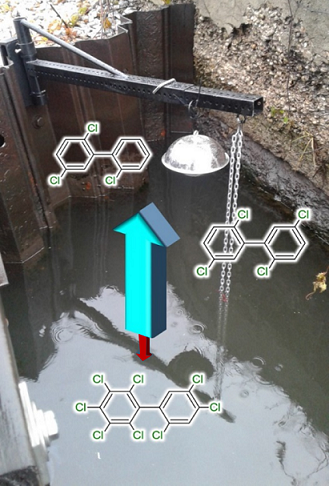Superfund Research Program
Passive Samplers Tackle PCB Flux
View Research Brief as PDF(529KB)
Release Date: 03/06/2019
![]() subscribe/listen via iTunes, download(5.2MB), Transcript(85KB)
subscribe/listen via iTunes, download(5.2MB), Transcript(85KB)
Researchers from the University of Iowa Superfund Research Program (SRP) Center have developed a method to measure the movement, or flux, of polychlorinated biphenyls (PCBs) from water to air using passive sampling devices. PCBs are a group of chemicals that were used for decades in insulation, coolants, and electrical equipment. Although commercial production of PCBs was banned in the United States in 1979, they persist in the environment because of their stable chemical structure. PCBs are linked to increased risk of diabetes, heart disease, and cancer.
Measuring the flux of PCBs is important for understanding their movement from the dissolved phase in water to a gaseous phase in the air, but this has been a challenge with traditional approaches. The team, led by Andres Martinez, Ph.D., and Center Director Keri Hornbuckle, Ph.D., demonstrated that simple and cost-effective passive samplers could be used to overcome this challenge. By improving how PCB flux is measured, researchers can better understand and predict water- and airborne exposures to PCBs in communities living near contaminated waterways.
The team used a dual-sampling system of polyurethane foam passive air (PUF-PAS) and low-density polyethylene (LDPE) water samplers to simultaneously measure PCBs in water and surrounding air. PUF-PAS and LDPE samplers are frequently used to capture and measure persistent organic pollutants like PCBs.
Using measured water and air concentrations over time, they were able to calculate the direction and magnitude of PCB flux. According to the authors, passive sampling devices like these can reduce uncertainty and improve the sensitivity and accuracy of analytical methods.
Characterizing PCB Flux
The samplers were deployed in the Indiana Harbor and Ship Canal. In the lab, PCBs were extracted from those samplers, and an analytical approach called gas chromatography tandem mass spectrometry was used to identify and quantify all 209 PCB chemicals in the samples.

The team found a strong relationship between the concentration of PCBs dissolved in the water and the concentration of PCBs in the air. Measurements of PCBs in water and air both increased over the course of the study.
According to the authors, one explanation for the increased concentrations is the seasonal increase in temperature over the year-long study. They reported a strong relationship between the concentration of PCBs in the water and temperature, which the authors suggest may be related to increased biological activity releasing more PCBs from the sediment into the water. Another explanation for the increase in PCB levels is the discharge released from a confined disposal facility that stores sediment from dredging operations, though both factors could contribute.
The researchers then used measured concentrations and chemical properties of PCBs to calculate flux. Although there was some variation among specific PCB chemicals, they found that PCBs tended to move from the water to the air, a process called volatilization. They reported that individual PCB chemicals had a tendency toward volatilization 90 percent of the time.
Understanding Changes Over Time
The team further compared their results to an earlier study in which they used active sampling devices at the same location. Using mathematical adjustments to account for differences in the two approaches, the team found a 50 percent reduction in overall PCB concentrations and a 60 percent reduction in PCB flux between the earlier study and the current study.
According to the authors, this reduction could be due in part to efforts to control upstream sources of PCBs over the years and to sediment dredging activities that occurred between 2012 and 2017. The dredging removed PCB-contaminated sediment from the bottom of the harbor to reduce the exposure of fish, wildlife, and people to PCBs and to prevent the spread of the contaminants to other areas.
They suggest that more monitoring is needed to better evaluate changes in PCB flux due to clean-up activities like dredging and that passive samplers offer an efficient and appropriate method of doing so.
For More Information Contact:
Keri C. Hornbuckle
University of Iowa
Department of Civil and Environmental Engineering
Iowa City, Iowa 52242
Phone: 319-384-0789
Email: keri-hornbuckle@uiowa.edu
To learn more about this research, please refer to the following sources:
- Martinez A, Awad AM, Herkert N, Hornbuckle KC. 2019. Determination of PCB fluxes from Indiana Harbor and Ship Canal using dual-deployed air and water passive samplers. Environ Pollut 244:469-476. doi:10.1016/j.envpol.2018.10.048 PMID:30366294 PMCID:PMC6277018
- Martinez A, Wang K, Hornbuckle KC. 2010. Fate of PCB congeners in an industrial harbor of Lake Michigan. Environ Sci Technol 44:2803-2808. doi:10.1021/es902911a PMID:20131898 PMCID:PMC3257175
To receive monthly mailings of the Research Briefs, send your email address to srpinfo@niehs.nih.gov.


